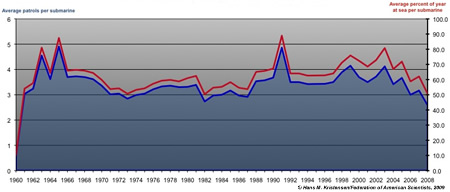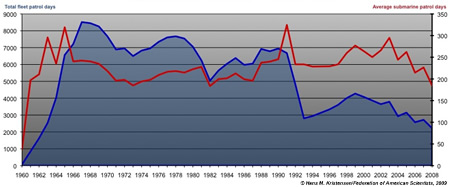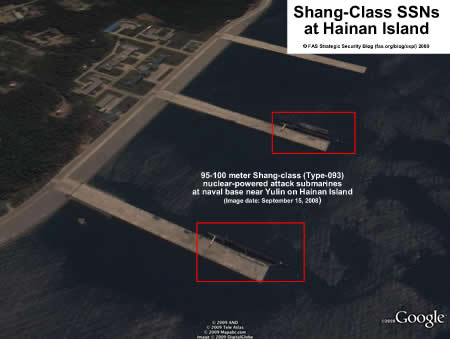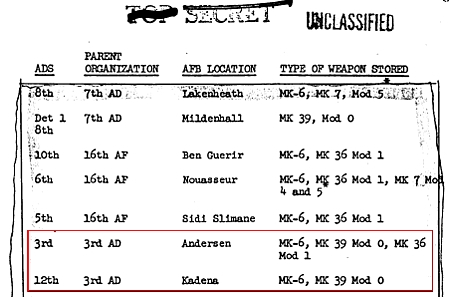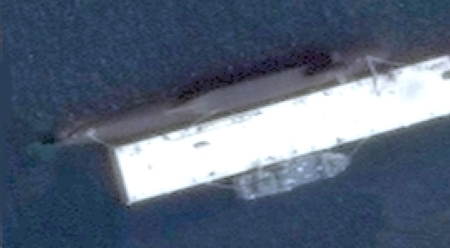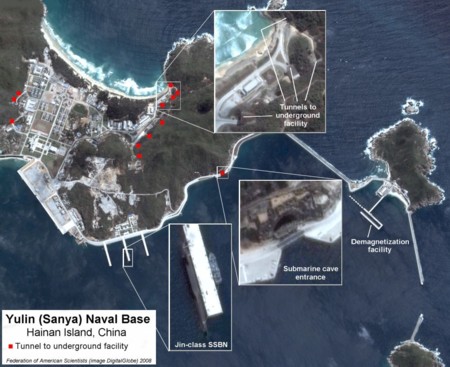U.S. Strategic Submarine Patrols Continue at Near Cold War Tempo
 |
| U.S. ballistic missile submarines conducted 31 nuclear deterrent patrols in 2008 at an operational tempo comparable to that of the Cold War. |
.
By Hans M. Kristensen [updated]
The U.S. fleet of 14 nuclear-powered ballistic missile submarines conducted 31 nuclear deterrent patrols in 2008 at an operational tempo comparable to during the Cold War.
The new patrol information, which was obtained from the U.S. Navy under the Freedom of Information Act, coincides with the completion on February 11, 2009, of the 1,000th deterrent patrol by an Ohio-class submarine since 1982.
The information shows that the United States conducts more nuclear deterrent patrols each year than Russia, France, United Kingdom and China combined.
Patrols by the Number
The 31 patrols conducted in 2008 top a 48-year history of continuous deterrent patrols. Since the USS George Washington (SSBN-598) departed Charleston, S.C., on the first nuclear-powered ballistic missile submarine (SSBN) patrol on November 15, 1960, 59 SSBNs have conducted 3,814 patrols through 2008 (see Figure 1).
.
The annual number of patrols has fluctuated considerably over the years, peaking at 131 patrols in 1967. Declines occurred mainly due to retirement of SSBNs rather than changes in the mission. The retirement of the early classes of SSBNs in 1979-1981 almost eliminated patrols in the Pacific, but the new Ohio-class gradually rebuilt the posture. The stand-down of Poseidon SSBNs in October 1991 and the retirement of all non-Ohio-class SSBNs by 1993 reduced Atlantic patrols by nearly 60 percent. The patrols increased again in the second half of the 1990s and more Ohio-class SSBNs were added to the fleet, but started dropping from 2000 as four Ohio-class SSBNs were withdrawn from nuclear missions and four others underwent lengthy backfits from the Trident I C4 to the Trident II D5 Trident missile.
|
Figure 2: |
 |
|
The United States conducts more SSBN patrols than all other nuclear powers combined. China’s SSBNs have yet to conduct a deterrent patrol. |
During the Cold War standoff with the Soviet Union, the vast majority of patrols were done in the Atlantic Ocean. Since the early 1990s, patrols in the Atlantic have plummeted and the SSBN force been concentrated on the west coast. The majority of U.S. SSBN patrols today occur in the Pacific.
The current number of patrols is significantly greater than the patrol levels of other countries with sea-based nuclear weapon systems. In fact, the U.S. navy conducted three times the number of SSBN patrols that the Russian navy did in 2008, and more patrols than Russia, France, Britain and China combined (see figure 2).
High Operational Tempo
Although the total annual number of SSBN patrols has decreased significantly since the end of the Cold War, the operational tempo of each submarine has not. Each Ohio-class SSBNs today conducts about the same number of patrols per year as during the Cold War, but the duration of each patrol has increased, with each submarine spending approximately 50-60 percent of its time on patrol (see Figure 3).
.
The high operational tempo is made possibly by each SSBN having two crews, Blue and Gold. Each time a submarine returns from a patrol, the other crew takes over, spends a few weeks repairing and replenishing the boat, and takes the SSBN out for its next patrol.
The data also reveals a couple of interesting spikes of increased patrols in 1963/1965 and 1991. The reasons for this increased activity is not known but the periods coincide with the Cuban missile crisis and the failed coup attempt in the final days of the Soviet Union in 1991.
Another way to examine the data is to see how may patrol days each submarine and the fleet accumulate each year. During the Cold War the larger submarine fleet averaged approximately 6,000 patrol days each year, with a peak of 8,515 patrol days in 1967. That performance declined to an average of 3,400 days in the post-Cold War era as the size of the SSBN fleet was reduced. With the removal of four SSBNs from nuclear operations and four others undergoing lengthy missile backfits, the fleet’s total patrol days has now dropped to a little over 2,200 (see figure 4).
.
Yet total patrol day numbers can be deceiving because they can obscure how each submarine is doing. Because the Ohio-class SSBN design was optimized for lengthy deterrent patrols, the average number of days each submarine spends on patrol has been higher in the post-Cold War period than during the Cold War itself. Patrols can be shortened by technical problems, but many Ohio-class submarines today stay on patrol for more than 80 days. Last year, the USS Maine (SSBN-741) conducted a 98-day patrol in the Pacific.
What is a Deterrent Patrol?
An SSBN deterrent patrol is an extended operational deployment during part of which the submarine covers its assigned target package in support of the strategic war plan. Each Ohio-class patrol typically lasts 60-90 days, but one submarine in late 2008 conducted an extended patrol of 98 day and patrols have occasionally exceeded 100 days. Occasionally a patrol is cut short by technical problems, in which case another SSBN can be deployed on short notice. As a result, patrols today in average last about 72 days.
Being on patrol does not mean the submarine is continuously submerged on-station and holding targets at risk. In fact, when the submarine is not on Hard Alert holding targets at risk in Russia, China, or regional states, much of the patrol time is spent on cruising between homeport, patrol areas, exercising with other naval forces, undergoing inspections and certifications, performing Weapon System Readiness Tests (WSRTs), conducting retargeting exercises, and Command and Control exercises.
Another activity involves so-called SCOOP exercises (SSBN Continuity of Operations Program) where the SSBN will practice replenishment or refit in forward ports in case the homeport is annihilated in wartime. In the Pacific, the SCOOP ports include Pearl Harbor, Hawaii (see Figure 5), Guam, Seaward, Alaska, Astoria, Oregon, and San Diego, California. In the Atlantic they include Port Canaveral and Mayport, Florida, Roosevelt Roads, Puerto Rico, and Halifax, Canada. The SSBN may even return to its homeport and redeploy a day or two later on the same patrol.
|
Figure 5: |
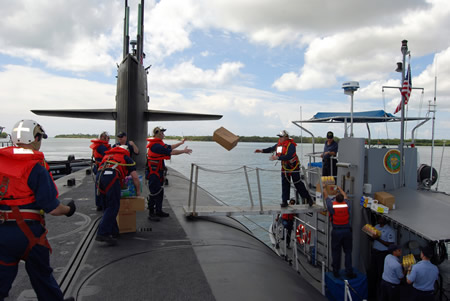 |
| USS Henry M. Jackson (SSBN-730) loading fresh fruit in Pearl Harbor during a SCOOP visit to Hawaii in March 2008 on its first patrol after a four-year overhaul where it was refueled and modernized to carry the Trident II D5 ballistic missile. |
.
Although patrols normally end at the base where they started, this is not always the case. An SSBN that departs Naval Submarine Base Bangor, Washington, might go on-station for several weeks in alert operational areas, conduct various training and exercises, and then arrive at Pearl Harbor in Hawaii. After a brief port visit and replenishment the submarine typically resumes its patrol and eventually returns to Bangor. But sometimes the patrol will end in Hawaii, a new crew be flown in to replace the old, and the submarine undergo refit at the forward location as part of a SCOOP exercise. The SSBN then departs Hawaii on a new patrol, goes on-station in alert operational areas, conducts more exercises and inspections, and eventually returns to Bangor where the new patrol ends.
This type of broken up patrol where the submarine is allowed to do more than on-station operations is sometimes described as “modified alert” and said to be different from the Cold War. But SSBNs have never been on-station all the time, with most deployed submarines being in transit between on-station alert areas and other non-alert operations. In fact, “modified alert” patrols date back to the early 1970s.
Of the 14 SSBNs currently in the fleet, two are normally in overhaul at any given time. Of the remaining operational 12 submarines, 8-9 are deployed on patrol at any given time. Four of these (two in each ocean) are on “Hard Alert” while the 4-5 non-alert SSBNs can be brought to alert level within a relatively short time if necessary. One to three SSBNs are in refit at the home base in preparation for their next patrol.
The SSBNs on Hard Alert continuously hold at risk facilities in Russia, China and regional states with an estimated 384 nuclear warheads on 96 Trident II D5 missiles that can be launched within “a few minutes” after receiving the launch order. The targets in the “target packages” are selected based on the taskings of the strategic war plan, known today as Operations Plan (OPLAN) 8010.
What is the Mission?
But why, nearly two decades after the Cold War ended, are 28 crews ordered to sail 14 SSBNs with more than 1,000 nuclear warheads on 30-plus patrols each year at an operational tempo comparable to that of the Cold War?
The official line is, as stated last month by Secretary of the Navy Donald Winter during the celebration of the 1,000th Ohio-class deterrent patrol, that “the ability of our Trident fleet to [be ready to launch its missiles] 24 hours a day, seven days a week, 365 days a year, has promoted the interests of peace and freedom around the world….Since the beginning of the nuclear age, the world has seen a drastic reduction in wartime deaths.”
|
Figure 6: |
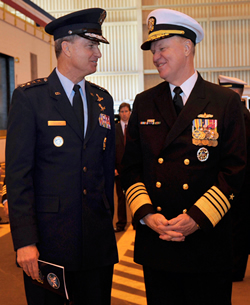 |
|
STRATCOM commander General Kevin Chilton (left) and Chief of Naval Operations Admiral Gary Roughead. General Chilton says SSBNs deter not only nuclear conflict but “conflict in general” and are “as equally important today, as they ever were during the height of the Cold War.” |
The warfighters add more nuances, including Commander Jeff Grimes of the Trident submarine USS Maryland (SSBN-738) who at the start of a recent deterrent patrol explained it to Navy Times: “There are nuclear weapons in the world today. Many nations have them. Proliferation is possible in the growing technologies societies have. The power of the deterrent is the knowledge that the capability exists in the hands of controlled people. So on a global scale, deterrence is showing how it’s working every day. We haven’t had a global, world war, in a long time,” he said. “Intelligence is different, the threats are different, so we do adjust the planning and contingencies for strategic operations continually to face the threats that may or may not be seen….We’re there on the front line, ready to go,” Grimes declared.
STRATCOM commander General Kevin Chilton, who in a war would advise the president on which nuclear strike options to use, said recently that although some people thought the Trident mission would end with the 1991 collapse of the Soviet Union, the SSBNs “are as equally important today, as they ever were during the height of the Cold War….The application of deterrence can actually be more complicated in the 21st century, but some fundamentals don’t change,” he said and added: “And it is not just to deter nuclear conflict. These forces have served to deter conflict in general, writ large, since they’ve been fielded.”
These are strong and diverse claims that are also made in some of the command histories that each SSBN produces. Some of them state that the mission is to “maintain world peace,” which has certainly not been the case in the post-Cold War era. Others describe the mission as “providing strategic deterrence to prevent nuclear war” (my emphasis), which sounds more credible. But even in that case, can we really tell whether it is the SSBNs that prevent nuclear war and not the ICBMs or bombers?
The enormous differences between maintaining world peace, preventing wars, and preventing nuclear war demand that officials articulate the SSBN mission much more clearly. To that end, it would be good to hear why it takes 12 operational SSBNs with more than 1,100 nuclear warheads on 30-plus patrols per year to deter nuclear attack against the United States, but only three operational SSBNs with less than 160 warheads on six patrols per year to safeguard the United Kingdom.
|
Figure 7: |
 |
| USS Maryland (SSBN-738) departs Kings Bay on February 15, 2009, for its 53rd deterrent patrol in the Atlantic Ocean to prevent nuclear war, prevent world war, deter conflict, maintain world peace, promote the interests of peace of freedom, deter proliferators, in a mission that remains“equally important…as during the height of the Cold War,” depending on who is describing it. |
.
Last year Russia’s SSBNs returned to sea at a level not seen in a decade and it plans to build eight new Borey-class SSBNs with new multi-warhead missiles. France is completing its fourth Triomphant-class SSBNs also with a new multi-warhead missile, and Britain has announced plans to build four new SSBNs. China is building 3-5 new Jin-class SSBNs with 8000-kilometer missiles, and India is said to be working on an SSBN as well. The U.S. Navy has also begun design work on its next ballistic missile submarine to replace the Ohio-class.
In short, the nuclear powers seem to be recommitting themselves to an era of deploying large numbers of nuclear weapons in the oceans. Most people tend to view sea-based nuclear weapons as the most legitimate leg of the Triad. Yet of all strategic nuclear weapons, sea-based ballistic missiles are the most difficult to track, the most problematic to communicate with in a crisis, the hardest to verify in an arms control agreement, and the only ones that can sneak up on an adversary in a surprise attack.
If the Obama administration wants to decisively move the world toward “dramatic reductions” and ultimately the elimination of nuclear weapons, then it must seek answers to these issues. In the short term, it needs to ask whether the Cold War operational tempo of U.S. SSBNs is counterproductive by sending a signal to other nuclear weapon states that triggers modernization of their forces and makes reductions harder to achieve than otherwise. In other words, what is the net impact of the SSBN patrols on U.S. national security objectives in an era of pursuing nuclear disarmament?
Addition Resources: Russian Sub Patrols | Chinese Sub Patrols
_____________________________________________________________
US-Chinese Anti-Submarine Cat and Mouse Game in South China Sea
 |
| The Chinese military harassment of a U.S. submarine surveillance vessel Sunday occurred only 75 miles from China’s growing naval base near Yulin on Hainan Island. |
.
By Hans M. Kristensen [updated 1:50 P.M., 3/10/09]
The incident that unfolded in the South China Sea Sunday, where the U.S. Navy says five Chinese ships harassed the U.S. submarine surveillance vessel USNS Impeccable, appears to be part of a wider and dangerous cat and mouse game between U.S. and Chinese submarines and their hunters.
News media reports cite Pentagon reports of half a dozen other incidents just within the past week in which U.S. surveillance vessels were “subjected to aggressive behavior, including dozens of fly-bys by Chinese Y-12 maritime surveillance aircraft.”
The latest incident allegedly occurred in international waters only 75 miles south of a budding naval base near Yulin on Hainan Island from where China has started operating new nuclear attack and ballistic missile submarines. The U.S. Navy on its part is busy collecting data on the submarines and seafloor to improve its ability to detect the submarines in peacetime and more efficiently hunt them in case of war.
|
USNS Impeccable (T-AGOS-23) |
 |
|
The USNS Impeccable was designed specifically as a platform for the SURTASS towed array and its Low Frequency Array upgrade. |
An Impeccable “Civilian Crew”
The U.S. Navy’s description of the incident states that “a civilian crew mans the ship, which operates under the auspices of the Military Sealift Command.” Yet as one of five ocean surveillance ships, the USNS Impeccable (T-AGOS 23) has the important military mission of using its array of both passive and active low frequency sonar arrays to detect and track submarines. The USNS Impeccable works directly with the Navy’s fleets, and in 2007 operated with the three-carrier strike battle group in Valiant Shield 07 exercise in the Western Pacific.
USNS Impeccable is equipped with the Surveillance Towed Array Sensor System (SURTASS), a passive linear underwater surveillance array attached to a tow cable. SURTASS was developed as a floating submarine detection system for deep waters, and the Navy wants to add an active Low Frequency Array (LFA) to improve long-range detection of submarines in shallow waters.
|
SURTASS LFA Deployment |
 |
| The SURTASS LFA passive-active surveillance system is designed to detect submarines and surface ships at long range in deep and shallow waters. |
.
Indeed, according to the U.S. Navy, the USNS Impeccable is “designed specifically as a platform for the SURTASS towed array and its LFA adjunct.”
New Chinese Nuclear Submarines at Yulin Naval Base
Among Chinese submarines the USNS Impeccable was monitoring is probably the Shang-class (Type-093) nuclear-powered attack submarine, a new class China is building to replace the old Han-class, and which has recently been seen at the Yulin base.
A commercial satellite image taken September 15, 2008, shows two Shang-class submarines present at the base, the first time – to my knowledge – that two Shang-class SSNs have been seen at the base at the same time.
.
An earlier image from February 2008 showed a Jin-class (Type-094) ballistic missile submarine at the Hainan base for the first time. The Jin-class is not visible on the later image. China has been reducing its submarine fleet by replacing old boats with fewer modern ones. The submarines normally stay close to shore, but in 2008 sailed on 12 longer patrols – twice as many as in 2007.
Time For an Incident Agreement
The incident begs the question who or at what level in the Chinese government the harassment in international waters was ordered. The incident will make life harder for those in the Obama administration who want to ease the military pressure on U.S.-Chinese relations, and easier for hardliners to argue their case.
For both countries the Sunday incident and the many other incidents that have occurred recently are reminders that the time is long overdue for an agreement to regulate military operations. Following a break in response to U.S. military sales to Taiwan, U.S.-Chinese mid-level military-to-military talks were scheduled to resume last month, and the Commander of U.S. Pacific Command, Admiral Timothy Keating, said “nascent initiatives” were underway to draw up some “rules of the road” to address some of these issues.
Absent a substantial agreement, building on the 1998 US-Chinese Military Maritime Safety Agreement (which already includes discussions on “interpretation of the Rules of the Nautical Road and avoidance of accidents-at-sea”) and the 1972 US-Russian Incidents at Sea Agreement, incidents like the USNS Impeccable incident will continue as a serious irritant and source of mistrust between China and the United States, a situation neither country nor other nations in the region can afford.
Additional resources: US-Chinese Military Maritime Safety Agreement (1998) | US-Russian Incidents at Sea Agreement (1972) | Secrecy News Blog: U.S., China, and Incidents at Sea
Chinese Submarine Patrols Doubled in 2008
 |
| Chinese submarines conducted 12 patrols in 2008, the highest ever. |
.
By Hans M. Kristensen
Chinese attack submarines sailed on more patrols in 2008 than ever before, according to information obtained by Federation of American Scientists from U.S. naval intelligence.
The information, which was declassified by U.S. naval intelligence in response to a Freedom of Information Act request from the Federation of American Scientists, shows that China’s fleet of more than 50 attack submarines conducted 12 patrols in 2008, twice the number of patrols conducted in 2007.
China’s strategic ballistic missile submarines have never conducted a deterrent patrol.
Highest Patrol Rate Ever
The 12 patrols conducted in 2008 constitute the highest patrol rater ever for the Chinese submarine fleet. They follow six patrols conducted in 2007, two in 2006, and zero in 2005. China has four times refrained from conducting submarine patrols since 1981, and the previous peaks were six patrols conducted in 2000 and 2007 (see Figure 1).
|
Figure 1: |
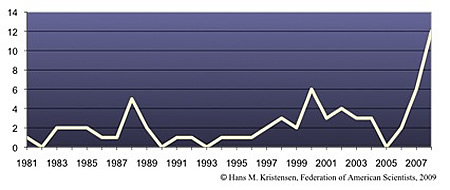 |
| Chinese attack submarines conducted 12 patrols in 2008, double the number from 2007. Yet Chinese ballistic missile submarines have yet to conduct a deterrent patrol. |
.
While the increase is submarine patrols is important, it has to be seen in comparison with the size of the Chinese submarine fleet. With approximately 54 submarines, the patrol rate means that each submarine on average goes on patrol once every four and a half years. In reality, the patrols might have been carried out by only a small portion of the fleet, perhaps the most modern and capable types. A new class of nuclear-powered Shang-class (Type-093) attack submarines is replacing the aging Han-class (Type-091).
Few of the details for assessing the implications of the increased patrol rate are known, nor is it known precisely what constitutes a patrol in order for U.S. naval intelligence to count it. A request for the definition has been denied. It is assumed that a patrol in this case involves an extended voyage far enough from the submarine’s base to be different from a brief training exercise.
In comparison with other major navies, twelve patrols are not much. The patrol rate of the U.S. attack submarine fleet, which is focused on long-range patrols and probably operate regularly near the Chinese coast, is much higher with each submarine conducting at least one extended patrol per year. But the Chinese patrol rate is higher than that of the Russian navy, which in 2008 conducted only seven attack submarine patrols, the same as in 2007.
Still no SSBN Patrols
The declassified information also shows that China has yet to send one of its strategic submarines on patrol. The old Xia, China’s first SSBN, completed a multi-year overhaul in late-2007 but did not sail on patrol in 2008.
 |
| Neither the Xia-class (Type-092) ballistic missile submarine (image) nor the new Jin-class (Type-094) have ever conducted a deterrent patrol. |
.
The first of China’s new Jin-class (Type-094) SSBN was spotted in February 2008 at the relatively new base on Hainan Island, where a new submarine demagnetization facility has been constructed. But the submarine did not conduct a patrol the remainder of the year. A JL-2 missile was test launched Bohai Bay in May 2008, but it is yet unclear from what platform.
Two or three more Jin-class subs are under construction at the Huludao (Bohai) Shipyard, and the Pentagon projects that up to five might be built. How these submarines will be operated as a “counter-attack” deterrent remains to be seen, but they will be starting from scratch.
China Defense White Paper Describes Nuclear Escalation
 |
.
By Hans M. Kristensen
A Chinese government defense white paper for the first time describes how China’s nuclear forces would gradually be brought to increased levels of alert during a crisis to deter an adversary and retaliate to nuclear attack.
The paper describes a growing portfolio of deterrence and counterattack capabilities with an ambitious agenda to control war situations with a more flexible deterrent and strategy.
Despite shortcomings, the paper provides a new level of Chinese transparency about its forces and planning.
Nuclear Escalation Phases
The white paper describes how the Second Artillery Corps (or Force, the term used by the paper) would change the operational status of the nuclear forces at different levels of crisis and conflict. Three levels of escalation are described:
Peacetime: Under normal circumstances – “in peacetime” – China’s nuclear missiles are “not aimed at any country.” The term “not aimed at any country” seems borrowed from U.S. terminology where it refers to the absence of targeting data in a missile’s guidance system rather than the alert level of the weapon. It has been assumed for many years that Chinese warheads were not mated with liquid-fuel missiles under normal circumstances (The situation with solid-fuel missiles has been less clear but might be similar).
|
Figure 1: |
 |
|
A warhead section is mated with a DF-3 liquid-fuel ballistic missile. Chinese nuclear warheads are thought to be stored separate from the missiles in peacetime. Image: web |
Nuclear crisis: If China comes under a nuclear threat, the nuclear missile force of the Second Artillery Corps “will go into a state of alert, and get ready for a nuclear counterattack to deter the enemy from using nuclear weapons against China.” In this phase, depending on the situation, mobile missiles would probably be dispersed to their deployments areas and presumably be aimed at the particular threat. If nuclear warheads were not already mated, they would be so too.
Nuclear attack: If China is attacked with nuclear weapons, the nuclear missile force of the Second Artillery Corps “will use nuclear missiles to launch a resolute counterattack against the enemy either independently or together with the nuclear forces of other services.” The “nuclear forces of other services” probably refers to the navy’s SSBNs and the Air Force’s bombers (see below).
Nuclear Missile Submarines
The submarine force is said to be equipped with “nuclear-powered strategic missile submarines,” a vague reference to the small fleet of perhaps 3-4 Jin-class SSBNs under construction.
The first was spotted at Xiaopingdao Submarine Base in 2007 and Hainan Island in 2008, the old Xia ended a multi-year overhaul at Jianggezhuang Submarine Base in 2008, although its operational condition is unknown.
The mission of the SSBNs is said to be “strategic deterrence and strategic counterattack,” which probably means non-alert operations in peacetime, increased readiness in a crisis, and the ability to counterattack in wartime. The paper states that the ability to counterattack is being improved, probably a reference to the new JL-2 SLBM on the Jin-class.
The mission description is vague and inconsistent. Whereas the section describing the navy’s development history uses the term “strategic deterrence and strategic counterattack,” the general force building section states that, “the submarine force possesses underwater anti-ship, anti-submarine and mine-laying capabilities, as well as some nuclear counterattack capabilities.”
Why the authors have used “strategic deterrence” in one part but only “nuclear counterattack capabilities” in the second part is unclear. Whether it is a vague reference to a nuclear cruise missile capability being added to some attack submarines is unknown, but absent any additional information might just be a matter of language.
A New Air Force Capability?
The Air Force section is interesting because it describes a “transition from territorial air defense to both offensive and defensive operations.” While much of this has to do with the introduction of new and more capable fighter and bomber aircraft and new concepts of operations, the white paper also describes “certain capabilities to execute long-range precision strikes and strategic projection operations.”
The force building section adds that in addition to traditional air force missions such as strikes and air defense, the transition involves increasing the capabilities for “strategic projection, in an effort to build itself into a modernized strategic air force.”
A small portion of China’s H-6 bombers have for decades been thought to have a secondary nuclear mission with gravity bombs, but the language in the white paper appears to go beyond that and might refer to some of the H-6 bombers being upgraded to carry a new long-range cruise missile intended for land-attack missions.
Most new cruise missiles will carry conventional explosives, but at least one – possibly the DH-10 – might also have a nuclear capability. The operational status of a nuclear cruise missile is highly uncertain and may initially be ground-launched, yet the U.S. Defense Department’s 2008 projection for Chinese nuclear forces vaguely referred to “new air- and ground-launched cruise missiles that could perform nuclear missions” and therefore “improve the survivability, flexibility, and effectiveness of China’s nuclear forces.”
Whether that means China is deploying nuclear cruise missiles remains to be seen.
Nuclear Weapons Capabilities
The paper describes that China over the past decades has built a weaponry and equipment system with both nuclear and conventional missiles, both solid-fueled and liquid-fueled missiles, with different ranges and “different types of warheads.”
The safety and surety features of those warheads and the personnel that handle them have been changed, the white paper states. For example, safety measures have been established to “avoid unauthorized and accidental launches,” measures that are needed for enhancing security but probably also for enhancing command and control of the weapons in the increasingly flexible scenarios the paper describes.
|
Figure 2: |
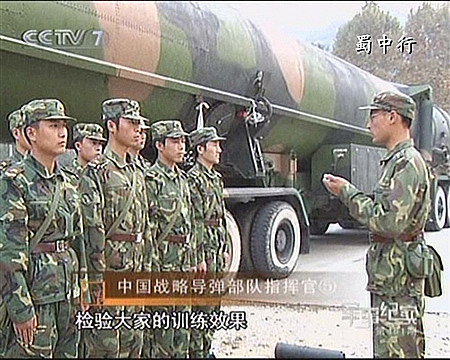 |
| Do Chinese solid-fuel DF-31 and DF-31A long-range ballistic missiles carry nuclear warheads in peacetime? In a crisis they most likely would under the escalation procedures described in the 2008 Defense White Paper. Image: CCTV7 |
.
Nuclear Weapons Policy
The white paper states that new military strategic guidelines have been issued that are aimed at “winning local wars in conditions of informationization.” The new guidelines stress “deterring crises and wars,” and “effectively control war situations,” and calls for “the building of a lean and effective deterrent force and the flexible use of different means of deterrence.”
Hovering above that evolution is a long-held policy of no-first-use of nuclear weapons, a self-defensive nuclear strategy, and a pledge never to enter into a nuclear arms race with any other country.
The good news about the no-first-use policy is that it is explicitly nuclear focused, and that China does not yet appear to have made it conditional on specific situations such as conventional attacks against China’s nuclear forces. This is important because some Chinese officials privately insist that a conventional attack against China’s nuclear forces would be considered a nuclear attack and the no-first-use policy therefore not a limiting factor in China’s response.
The not so good news is that the no-first-use policy in certain situations doesn’t seem credible. The pledge to “not be the first to use nuclear weapons at any time and in any circumstances” means that if an adversary invaded China and threatened the survival of the state, China’s nuclear forces would not be used as long as the invader did not use nuclear weapons. Hardly a credible policy.
Likewise, the pledge to “unconditionally not use or threaten to use nuclear weapons against non-nuclear-weapon states or in nuclear-weapon-free zones,” means that if the United States staged strikes against China from Japan or South Korea, Chinese nuclear weapons would not be used against U.S. bases in those countries. In that credible?
Despite these “credibility issues” in Chinese nuclear policy, the white paper is noteworthy because it indicates that China – unlike the other nuclear weapon states – has not yet fallen for the temptation to broaden its nuclear policy to deter all forms of weapons of mass destruction. The policy seems entirely focused on deterring and responding to nuclear attacks.
The white paper also states that China would like the nuclear weapon states to stop research into and development of new types of nuclear weapons, reduce the role of nuclear weapons in their national security policy, and reduce their nuclear arsenals. Those are good policy goals but they ring hollow given that China is busy deploying new nuclear weapons with new nuclear warheads and is the only of the five original nuclear weapon states that is thought to be increasing its nuclear arsenal.
As China increases its capabilities and pursues a more flexible deterrent posture, there is a risk that its policies will be modified too. With increased flexibility in capability tends to come increased flexibility in mission.
Oh, and in case you wondered: while the U.S. military plans against “red forces,” the Chinese plan against “blue forces.” Some things never change.
Nuclear Déjà Vu At Carnegie
 By Ivan Oelrich and Hans M. Kristensen
By Ivan Oelrich and Hans M. Kristensen
Only one week before Barack Obama is expected to win the presidential election, Defense Secretary Robert Gates made one last pitch for the Bush administration’s nuclear policy during a speech Tuesday at the Carnegie Endowment for International Peace.
What is the opposite of visionary? Whatever, that’s the word that best describes Mr. Gates’s speech. Had it been delivered in the mid-1990s it would not have sounded out of place. The theme was that the world is the way the world is and, not only is there little to be done about changing the world, our response pretty much has to be more of the same.
Granted, Gates’s job is to implement nuclear policy not change it but, at a time when Russia is rattling its nuclear sabers, China is modernizing its forces, some regional states either have already acquired or are pursuing nuclear weapons, and yet inspired visions of a world free of nuclear weapons are entering the political mainstream, we had hoped for some new ideas. Rather than articulating ways to turn things around, Gates’ core message seemed to be to “hedge” and hunker down for the long haul. And, while his arguments are clearer than most, this speech is yet another example of faulty logic and sloppy definitions justifying unjustifiable nuclear weapons.
They Do It So We Must Do It Too
Reductions cannot go on forever, Secretary Gates argues because there is still a mission for nuclear weapons. Using language from the Clinton Administration, he says we can reduce our arsenal but we must also “hedge” against unexpected threats. He said, “Rising and resurgent powers, rogue nations pursuing nuclear weapons, proliferation of international terrorism, all demand that we preserve this hedge. There is no way to ignore efforts by rogue states such as North Korea and Iran to develop and deploy nuclear weapons or Russian or Chinese strategic modernization programs.”
While the potential threats he lists are real and must be addressed, how do nuclear weapons address these threats? And even if there were some nuclear component to our responses, the nature of those responses would be so varied that lumping these threats together muddles the issue. A nuclear response to international terrorism? Even if, for example, al Qaeda used a nuclear weapon to attack an American city, what target would we strike back at with a nuclear weapon? The implicit argument of symmetry is unsustainable. Just as we don’t respond to roadside bombs with our own roadside bombs, nor would we respond to chemical attack with chemical weapons or biological attack with biological weapons. We might respond to nuclear attack with nuclear weapons but we should not allow this to be an unstated assumption. The reason rogue nations, let’s say Iran and North Korea, are developing nuclear weapons is not to counter our nuclear weapons but as a counter to our overwhelming conventional capability. They certainly are not making the mistake of implicitly assuming symmetry.
The near universal logical sleight of hand is to make some argument for nuclear weapons, let’s say we need them because North Korea has them, and then, when people nod in agreement that we need nuclear weapons, let slip in the assumption that this implies we need the nuclear arsenal the administration wants. Not so fast. If North Korea has one, perhaps we need two, but that does not mean we need two thousand.
It helps to clarify the typically foggy nuke-think if we remove Russia and China from the picture and ask whether the United States could justify anything near its currently planned nuclear arsenal only to deter and defeat rogue states and terrorists. Of course not. And perhaps we don’t need nuclear weapons for regional scenarios at all, given our overwhelming conventional capabilities. So those odds and ends are thrown into the pot just to scare, not to explain, and not because there is any well thought out strategy for how nuclear weapons are going to stop a terrorist attack on an American city, or why it be an appropriate response to a regional state that doesn’t have the capability to threaten the survival of the United States.
Russia is a very different case: Russian long-range nuclear forces are the only things in the world today that could destroy us as a nation and society, just as we could destroy them. While relations with Russia are not friendly, no conceivable difference between the United States and Russia justifies this mutual hostage relationship. This pointless threat to our very existence persists because of a failure of imagination typified by this speech. In this case, it is the nuclear weapons that are creating the threat, not protecting us from it.
That Ole Warhead Production Fever
Whatever the supposed justification of nuclear weapons, the primary purpose of the Secretary’s speech seemed to be to promote the Reliable Replacement Warhead or RRW but again, his argument rests on hidden (and unjustified) assumptions and, at times, misstatements of fact. The basic premise is that, without testing, we are slowly but certainly losing confidence in the reliability of our nuclear arsenal. He said, “With every adjustment, we move farther away from the original design that was successfully tested when the weapons was first fielded.”
We do? The implication is that we have no other choice, what we could do in 1990 we simply can’t reproduce today, like handing a modern-day native American a hunk of flint and asking him to chip out an arrowhead. Why should this be? With a budget of billions of dollars, we can’t duplicate parts that we could make twenty years ago? We can spend billions on the National Ignition Facility to create the world’s most powerful laser but we can’t reproduce a 1980s O-ring? The problem the Secretary describes is certainly possible and something we have to be alert to but it isn’t inevitable; we can maintain weapons within design margins as long as we want and in the past—pre-RRW—that was precisely the plan. And parts of the weapon that are not the nuclear core of the bomb can be improved and modernized and tested as much as we want.
But Mr. Gates claims that we are slowly and helplessly drifting, “So the information on which we base our annual certification of the stockpile grows increasing dated and incomplete.” This implies the Stockpile Stewardship Program (SSP) has failed. We believe the Secretary is wrong. Everyone we have talked to who is familiar with the enormous effort that has gone into the SSP says that our understanding of nuclear weapons today is substantially greater than it was the day after our last nuclear test. Our knowledge of the aging of nuclear warheads is increasing faster than the warheads are aging. Early uncertainties and concerns about stability, for example, of the plutonium parts of the weapon have been resolved and the parts have been shown to be stable for many decades, if not a century or more. Our computer models are dramatically and significantly more detailed and sophisticated. In fact, one weapon designer has told us that, given a fixed budget, the best investment of your next dollar would never be in a nuclear test but in more inspections, more computer simulations, more replacement of non-nuclear components, more material tests, more frequent tritium replenishment, and so forth.
|
How Many Times Does Congress Have to Say No? |
 |
| Every time the Pentagon has proposed a new nuclear warhead since the end of the Cold War, Congress has refused to fund it. Now that the RRW appears to have been whacked, what will the next proposal for a new warhead look like? |
.
Aside from the question of the reliability of current warheads, Mr. Gates argues that we still need an RRW because we need to modernize. The British, French, Russians, and Chinese are modernizing so we must too, obviously. Why? Nuclear weapons are a mature technology. There is no new science in nuclear weapons. They are powerful, efficient explosives. They are intended to blow up things and they have specific missions, which typically involve blowing up specific things. If they can accomplish these missions, what is the problem? If the technology, even the weapons, is decades, even centuries old, if they work then they work. Nuclear weapons are not fighter planes or tanks or submarines, duking it out on a battlefield with the enemy’s opposite number, so our nuclear weapons should be evaluated with regard to the targets they are expected to destroy, not anyone else’s nuclear weapons. They can destroy the targets. We’re done.
The important factor is not the warhead but the delivery vehicle that is intended to bring the warhead to the target. And the reason the United States is not producing new nuclear weapons while Russia and China do is not because they can and we can’t, or they’re ahead and we’re behind, as the Secretary indicated. Rather, the United States has not been producing new nuclear weapons because it didn’t have to – the existing ones are more than adequate – and because not producing has been seen as much more important to U.S. foreign policy objectives. And if Russian and Chinese warhead production is a problem, why not propose how to influence them to change rather than advocating that we repeat their mistake?
The final argument for the RRW is that the US must maintain a nuclear production industry and the RRW is grist for that mill. But many of the RRW technologies and capabilities were developed by the very SSP that Gates now implies is failing. Six years ago – before they came up with RRW after having failed to get permission to build the Precision Low-Yield Weapon Design (PLYWD) and the Robust Nuclear Earth Penetrator (RNEP) – the National Nuclear Security Administration assured Congress: “We believe the life extension programs authorized by the Nuclear Weapons Council for the B61, W80, and the W76 will sufficiently exercise the design, production and certification capabilities of the weapons complex” (emphasis added). That assurance was given after the Foster Panel recommended, “developing new designs of robust, alternative warheads.” Now the claim suddenly is that the life extension programs do not sufficiently exercise the weapons complex. At least get the argument straight.
What’s Around the Corner?
We would be more sympathetic to the production argument if the fundamental minimal needs of the nuclear production industry were better thought out and justified, but what we see is an effort to maintain a slimmed down version of what we have without thinking through what we need. In fact, if maintaining the production industry is the core objective, we would have expected the administration to ask for an RRW design that doesn’t need a complex production industry, one that is extremely simple, perhaps using uranium rather than plutonium, perhaps a clunky design but one sure to work that does not require any sophisticated skills that must be maintained in standby in perpetuity.
We’re concerned that in the end Congress will accept a beefed-up life extension program – they seem to have already found a name for it: Advanced Certification Program – that will relax the restrictions for what modifications can be made to existing warheads in order to incorporate as much as the RRW concept as possible and add new capabilities if necessary. Unless the next president significantly changes the nuclear guidance for what the Pentagon is required to plan for, RRW-like proposals will likely continue to make it harder to create a national consensus on the future role of nuclear weapons. And Barack Obama has not explicitly rejected the RRW, but said he does “not support a premature decision to produce the RRW” and “will not authorize the development of new nuclear weapons and related capabilities.” Enhanced life-extended warheads could fit within such a policy.
In the end, justifying the nuclear weapons production industry is shaky because the justification for the weapons themselves is shaky, resting on assertion and Cold War momentum – as Gates’ speech illustrated – more than on rigorous assessments of missions and the security of the nation.
The Secretary’s speech was a disappointing missed opportunity. We are a bit perplexed about why he gave it and gave it now. Perhaps he is putting down a marker for a debate he expects in the next administration and Congress. We welcome that debate because we believe that, with careful attention to definition and no hidden assumptions, the arguments for nuclear weapons fade away.
State Department Arms Control Board Declares Cold War on China

After planning the war against Iraq, former Assistant Secretary of Defense Paul Wolfowitz now heads the State Department’s International Security Advisory Board that recommends a Cold War against China.
By Hans M. Kristensen
A report from an advisory board to Secretary of State Condoleezza Rice has recommended that the United States beefs up its nuclear, conventional, and space-based posture in the Pacific to counter China.
The report, which was first described in the Washington Times, portrays China’s military modernization and intentions in highly dramatic terms that appear go beyond the assessments published so far by the Defense Department and the intelligence community.
Although the Secretary of State asked for recommendations to move US-Chinese relations away from competition and conflict toward greater transparency, mutual confidence and enhanced cooperation, the board instead has produced a report that appears to recommend policies that would increase and deepen military competition and in essence constitute a small Cold War with China.
China’s “Creeping” Nuclear Doctrine
Although the report China’s Strategic Modernization – written by the International Security Advisory Board (ISAB) – deals with China’s overall military modernization, its focus is clearly on nuclear forces. What underpins China’s expansion of its offensive nuclear capabilities, the report says, is an “emerging creep toward a Chinese assured destruction capability” to create a “mutual vulnerability relationship” with the United States.
The objective is, an interpretation the authors say is supported by “numerous Chinese military statements,” for Beijing to get enough nuclear capability “to subject the United States to coercive nuclear threats to limit potential US intervention in a regional conflict” over Taiwan and oilfields in the South China Sea.
Yet “assured destruction,” to the extent that means confidence in a retaliatory capability against the United States and Russia, has been Chinese nuclear policy for decades. Increasing US and Russian nuclear capabilities, however, convinced Chinese planners that their deterrent might not survive. The current deployment of three long-range ballistic missile versions of the mobile DF-31 is supposed to restore the survivability of their strategic deterrent.
The “mutual vulnerability relationship” the authors say China is trying to create to deter the United States from defending Taiwan or limit US escalation options is a curious argument because it implies that the United States has not been vulnerable to Chinese nuclear threats in the past. In fact, US bases and allies in the Western Pacific have been vulnerable to Chinese attacks since the 1970s and the Continental United States since the early 1980s.
It is tempting to read the authors’ use of the terms “assured destruction” and “mutual vulnerability relationship” as borrowed components of “mutual assured destruction,” or MAD, the term for the nuclear relationship that existed between the United States and the Soviet Union during much of the Cold War.
But in responding to China’s nuclear modernization and policy, it is very important not to resort to Cold War-like worst-case analysis. To that end, two of the best analyzes on Chinese nuclear policy are Iain Johnston’s China’s New ‘Old Thinking:’ The Concept of Limited Deterrence, and Michael S. Chase and Evan Medeiros’ China’s Evolving Nuclear Calculus: Modernization and Doctrinal Debate. The ISAB members should read them.
Misperceptions or Just Out of Touch
The report contains several claims about Chinese nuclear forces and recommendations for counter-steps that appear out of sync with what the US intelligence community has stated and steps that the US has already taken. Some of the most noteworthy are listed below followed by my remarks:
* “By 2015, China is projected to have in excess of 100 nuclear-armed missiles…that could strike the United States.” Actually, the projection the intelligence community has made in public is for 60 ICBMs by 2010 and “about 75 to 100 warheads deployed primarily against the United States” by 2015. The ISAB report talks about targeting of the US “homeland.” If that includes Guam, then the force could reach a little above 100 by 2015 (it’s about 70 today). If “homeland” means the Continental United States, which has been the focus of the intelligence community’s projection, then a force carrying 75-100 warheads would likely include 20 DF-5As and 40-55 DF-31A. China so far is thought to have deployed fewer than 10 DF-31As.
* Some of the missiles “may be MIRVed” by 2015. What the intelligence community has said is that China has had the capability to MIRV its silo-based missiles for years but has not yet done so. MIRV on the mobile missiles, however, represents significant technical hurdles and “would be many years off,” according to the CIA, and “would probably require nuclear testing to get something that small.” Instead, if Chinese planners determine that the US missile defense system would degrade the effectiveness of the Chinese force, they “could use a DF-31 type RV for a multiple-RV payload for the CSS-4 in a few years,” the CIA stated in 2002. Even so, a multiple-RV payload is not necessarily the same as MIRV.
* China’s “substantial expansion” of its nuclear posture “includes development and deployment of…tactical nuclear arms, encompassing enhanced radiation weapons, nuclear artillery, and anti-ship missiles.” That would certainly be news if it were true, but the intelligence community hasn’t talked much about Chinese tactical nuclear weapons and what it has said has been contradictory, ranging from China might have some to “there is no evidence” that they have any. Several of China’s tests reportedly involved enhanced radiation or tactical warhead designs, but whether China is working on fielding tactical nuclear weapons has not been confirmed. China did conduct what appeared to be operational tests of tactical bombs in the past, which they might have fielded, but ISAB does not mention bombs.
* China’s modernization includes “a growing capability for Conventional Precision Strike and other anti-access/area-denial capabilities” including “submarine-launched ballistic missiles.” That China would use nuclear missiles on its future strategic submarines for “anti-access/area-denial” capabilities is news to me and would, if it were true, represent a dramatic change in Chinese nuclear policy. But I haven’t seen anything that suggests its true, and the overwhelming expectation is that China will use its SSBNs as a retaliatory strike force, if and when they manage to operationalize it.
* The US “should reaffirm its formal security guarantees to allies, including the nuclear umbrella.” The US does that regularly when it extends the security agreement with South Korea and Japan. In addition, in response to the North Korean nuclear test in October 2006, President Bush reaffirmed that “The United States will meet the full range of our deterrent and security commitments.” One week later, Secretary of State Condoleezza Rice arrived in Tokyo where she emphasized the nuclear component by saying that “the United States has the will and the capability to meet the full range – and I underscore full range – of its deterrent and security commitments to Japan.”
* The US should “pursue new missile defense capabilities, including taking full advantage of space,” to counter China’s growing nuclear capability. For a State Department advisory committee to recommend using missile defenses to counter Chinese nuclear missiles is, to say the least, interesting given that the State Department has publicly stated and assured the Chinese that the missile defense system “it is not directed against China.”
* The US should “publicly reaffirm its commitment to retain a forward-based US military presence in East Asia.” The US has actually done that quite explicitly over the past seven years by shifting the majority of its aircraft carrier battle groups and nuclear attack submarines to bases in the Pacific, by beginning to forward deploy nuclear attack submarines to Guam, by sending strategic B-2 and B-52 bombers on extended deployments to Guam, and by forward deploying the nuclear-powered aircraft carrier USS George Washington (CVN-75) to Japan. The Pentagon describes the recent Valiant Shield exercises as “the largest Pacific exercise since the Vietnam War.”
|
Pacific Exercises Now Biggest Since Vietnam War |
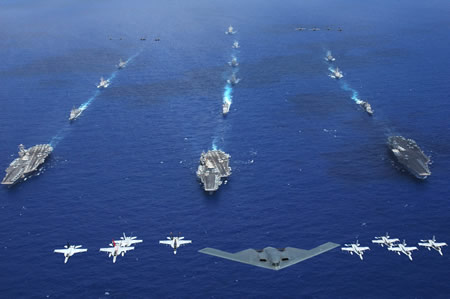 |
| While ISAB recommends increasing the US military posture in the Pacific to counter China, the Pentagon says recent exercises, including the thee carrier battle group Valiant Shield 06, are now the largest since the Vietnam War.
|
.
* “For almost two decades, the United States has allowed its nuclear posture – its stockpile, infrastructure, and expertise – to deteriorate and atrophy across the board.” Although the stockpile is much smaller compared with the Cold War and industrial-scale production of new nuclear warheads has ceased, ISAB’s characterization of the US nuclear posture is way off.
Instead, during the nearly two decades the authors describe (assuming that means since 1990), the US has deployed eight new SSBNs, deployed 336 Trident II D-5 SLBM on its entire SSBN fleet, deployed 21 B-2 stealth bombers, deployed the Advanced Cruise Missile, deployed the hard-target kill W88 warhead (including in the Pacific), deployed three modified nuclear weapons (B61-10, B61-11 and W76-1), completely overhauled the Minuteman III ICBM force, deployed two new classes of nuclear-powered attack submarines capable of launching nuclear cruise missiles, deployed a modern nuclear command and control system with new satellites and command centers, modernized the Strategic War Planning System (now called ISPAN), created a “living SIOP” strategic nuclear war plan with broadened targeting against China and new strike options against regional adversaries, and built a multi-billion dollar Science Based Stockpile Stewardship Program to certify the reliability of the nuclear stockpile without nuclear testing and provide weapons designers with unprecedented knowledge about warhead aging and the skills and tools to refurbish existing warheads or build modified ones.
Where Are The Non-Military Policy Recommendations?
One of the most striking features of the report is its almost complete focus on military options and the absence of other policy components. It contains no analysis of or recommendations for how to engage China on nuclear arms control or confidence building measures to limit or influence the nuclear modernization, operations and policy. It is almost as if there must be another unknown chapter to the report.
Although the authors believe there are a number of measures the US should take to reduce the prospect for misunderstanding and the chance of miscalculation, those recommendations are few and limited to continuing existing Track II discussions, military-to-military contacts, and asking the Chinese to be more transparent.
The report concludes that China does not desire a conflict with the United States, and describes a disconnect between the political and military leadership, and a “clear paranoia and misperceptions about US intentions….” Without presenting any analysis, it concludes that the US ability to shape or change Chinese choices related to its strategic modernization may be “very constrained” and that there is no point in trying to “educate” the Chinese.
On the contrary, the report concludes that the US should “reject” Chinese arms control proposals because they will constrain US military freedom. And US arms transfer to allied countries in the region “should be an important dimension of US non-proliferation policy.” Indeed, the “most important” policy recommendation is for the United States to “demonstrate its resolve to remain militarily strong….”
And in a recommendation blatantly “imported” from the Cold War, the authors say the US should “focus” its research and development on “high technology military capabilities” that China doesn’t have to “demonstrate to Beijing that trying to get ahead of the United States is futile (much the way SDI did against the Soviet Union.”
The report essentially capitulates on non-military policy options toward China.
So What Exactly Was ISAB Asked To Do?
The advisory board was asked to come up with ideas that could “move the US-China security relationship toward greater transparency and mutual confidence, enhance cooperation, and reduce the likelihood of misunderstanding or miscalculation that can contribute to competition or conflict.” That’s a quote!
Instead, the authors appear to have produced a paper that would – if implemented – likely move the US-Chinese security relationship in the opposite direction by deepening military competition and mistrust.
Indeed, the review looks more like the kind one would expect from the Pentagon rather than the State Department, which is supposed to pursue a wider set of policies and different agenda than the military. It is all the more striking given that the charter for ISAB – which used to be called the Arms Control and Nonproliferation Advisory Board (ACNAB) – describes that the board is supposed to “advise with and make recommendations to the Secretary of State on United States arms control, nonproliferation, and disarmament policies and activities.”
The Secretary’s hope has been for ISAB to provide “independent insight, advice, and innovation,” and serve as “a single advisory board, dealing with scientific, military, diplomatic, political, and public diplomacy aspects of arms control, disarmament, international security, and nonproliferation, would provide valuable independent insight and advice….”
Concluding Remarks
The militaristic focus of ISAB’s report and its lack of recommendations for arms control and broader public diplomacy to defuse rather than continuing and deepening the competitive and mistrustful relationship between the United States and China suggest that ISAB has failed to live up to its charter.
No matter what one might think of China’s military modernization, the ISAB appears instead to have drawn up a very effective plan for a Cold War with China.
Although the authors correctly state up front that the US-Chinese relationship “differs fundamentally from the US-Soviet relationship and the strategic rivalry of the Cold War,” they nonetheless land on a set of recommendations and observations that strongly resemble a China-version of the Reagan administration’s aggressive military posture against the Soviet Union.
If implemented or allowed to color US policy toward China, the policy recommendations would continue and very likely lead to a deepening of military competition and adversarial relationship between the United States and China – exactly the opposite of what the Board was asked to come up with. It is precisely reports like this that create the “deep paranoia and misperceptions about US intentions” in the Chinese military.
Secretary of State Condoleezza Rice should denounce the ISAB report to make it clear that the core of US policy toward China is not containment and Cold War posturing. And one of the first acts of the next Secretary should be to appoint a new advisory board that can – and will – develop recommendations that can “move the US-China security relationship toward greater transparency and mutual confidence, enhance cooperation, and reduce the likelihood of misunderstanding or miscalculation that can contribute to competition or conflict.” Mission not accomplished!
Background Information: ISAB Report: China’s Strategic Modernization | Chinese Nuclear Forces 2008 | US Nuclear Forces 2008 | FAS/NRDC Report: Chinese Nuclear Forces and U.S. Nuclear War Planning
Nuclear Policy Paper Embraces Clinton Era “Lead and Hedge” Strategy

By Hans M. Kristensen
The new nuclear policy paper National Security and Nuclear Weapons in the 21st Century published quietly Tuesday by the Defense and Energy Departments embraces the “lead and hedge” strategy of the first Clinton administration for how US nuclear forces and policy should evolve in the future.
Yet the “leading” is hard to find in the new paper, which seems focused on hedging.
Instead of offering different alternative options for US nuclear policy, the paper comes across as a Cold War-like threat-based analysis that draws a line in the sand against congressional calls for significant changes to US nuclear policy.
Strong Nuclear Reaffirmation
The paper presents a strong reaffirmation of an “essential and enduring” importance of nuclear weapons to US national security. Russia, China and regional “states of concern” – even terrorists and non-state actors – are listed as justifications for hedging with a nuclear arsenal “second to none” with new warheads that can adapt to changing needs.
Even within the New Triad – a concept presented by the 2001 Nuclear Posture Review as a way to decrease the role of nuclear weapons and increasing the role of conventional weapons and missile defense – the new paper states that nuclear weapons “underpin in a fundamental way these new capabilities.”
In defining the role of nuclear weapons, the paper borrows from and builds on statements, guidance and assertions about the role of nuclear weapons issued by the Clinton and Bush administrations during the past 15 years. This consensus seeking style presents a strong reaffirmation of the continued importance – even prominence – of nuclear weapons in US national security.
Threat-Based Analysis After All
Officials have argued for years that US military planning is no longer based on specific threats and that the security environment is too uncertain to predict them with certainty. But there is nothing uncertain about who the threats are in this paper, which seems to place renewed emphasis on threat-based analysis. The earlier version from 2007 did not mention Russia and China by name, but both countries and their nuclear modernizations are prominently described in the new paper.
Russia is said to have a broad nuclear modernization underway of all major weapons categories, increased emphasis on nuclear weapons in its national security policy and military doctrine, possess the largest inventory of non-strategic nuclear weapons in the world, and re-incorporated theater nuclear options into its military planning. This modernization, resumption of long-range bomber patrols, threats to target US missile defense systems in Europe with nuclear weapons, have created “considerable uncertainty” about Russia’s future course that makes it “prudent” for the US to hedge.
China is said to be the only major nuclear power that is expanding the size of its nuclear arsenal, qualitatively and quantitatively modernizing its nuclear forces, developing and deploying new classes of missiles, and upgrading older systems. The paper repeats the assessment from the 2006 Quadrennial Defense Review that “China has the greatest potential to compete militarily with the United States and field disruptive technologies that could, over time, offset traditional U.S. military advantages.” To that end, the paper indirectly points to China as having influenced the US force level planned for 2012 in “retaining a sufficient margin over countries with expanding nuclear arsenals….”
Regional “states of concern” – formerly known as rogue states – with (or developing) weapons of mass destruction are also highlighted in the paper as an enduring mission for US nuclear weapons. This broadened role for US nuclear weapons, which evolved during the 1990s and in 2003 led to incorporation of nuclear strike options into the US strategic war plan, focuses on Iran, North Korea and Syria. But the paper warns that a significant change in the “alignment among states of concern” in the future may require “adjustments to US deterrent capabilities.”
“Violent extremists and non-state actors” – commonly known as terrorists – are also listed as potential missions for US nuclear weapons. Most analysts agree that terrorists cannot or do not need to be affected by nuclear threats, so the paper instead declares that it is US policy “to hold state sponsors of terrorism accountable for the actions of their proxies.”
In addition to these potential threats, the paper describes how regional dynamics lead other nations, “such as India and Pakistan, to attach similar significance to their nuclear forces.” Israel is not mentioned in the paper.
And if all of this fails to impress, the paper also includes France and the United Kingdom to show that they have already committed themselves to extending and maintaining modern nuclear forces well into the 21st century.
These trends “clearly indicate the continued relevance of nuclear weapons, both today and in the foreseeable future,” the paper concludes. Therefore, it asserts, it is prudent that the United States maintains a viable nuclear capability that is “second to none” well into the 21st century.
Sizing a “Second to None” Nuclear Arsenal
“Second to none” means a US arsenal that is better than Russia’s arsenal. At the same time, the paper states that the criteria for sizing the US arsenal “are no longer based on the size of Russian forces and the accumulative targeting requirements for nuclear strike plans.” This has been said before and has confused many; some officials have even claimed that target plans do not affect the size of the arsenal at all. So the paper adds a lot of new information – probably the most interesting and valuable part of the paper – to clarify the situation:
| “Prior to the 2001 Nuclear Posture Review, force sizing considerations were based on target defeat criteria with the objective of rendering a nuclear-armed adversary incapable of prosecuting conflict, and terminating any conflict on terms favorable to the United States. U.S. Forces were sized to defeat all credible nuclear-armed adversary targets, and the United States retained a small reserve to ensure sufficient capability to deter further aggression in any post-exchange, post-conflict environment. Weapons were dedicated to specific targets, and the requirements for target defeat did not change dramatically year-to-year….” The 2001 NPR “made distinctions among the contingencies for which the United States must be prepared. These contingencies were categorized as immediate, potential, or unexpected….” “Instead, the size of the U.S. nuclear force is now based on the ability of the operationally deployed force, the force structure, and the supporting nuclear infrastructure to meet a spectrum of political and military goals. These considerations reflect the view that the political effects of U.S. strategic forces, particularly with respect to both central strategic deterrence and extended deterrence, are key to the full range of requirements for these forces and that those broader goals are not reflected fully by military targeting requirements alone.” |
.
Still confused? What I think they are trying to say is that the target sets for some contingencies no longer have to be covered by operationally deployed nuclear warheads on a day-by-day basis.
What has permitted this change is not a deletion of strike plans against the Russian target base per ce (which has shrunk considerably since the 1980s), but rather the extraordinary flexibility that has been added to the nuclear planning system and the weapons themselves over the past decade and a half. This flexible targeting capability – which ironically was started in the late 1980s in an effort to hunt down Soviet mobile missile launchers – has since produced a capability to rapidly target or retarget warheads in adaptively planned scenarios. Put simply, it is no longer necessary to “tie down” entire sections of the force to a particular scenario or group of targets (although some targets due to their characteristics necessitate use of certain warheads).
The more flexible war plan that exists today, which the 1,700-2,200 operational deployed strategic warhead level of the SORT agreement is sized to meet, is “a family of plans applicable to a wider range of scenarios” with “more flexible options” for potential use “in a wider range of contingencies.” And although they are no longer the same kind of strike plans that existed in the 1980s, some of them still cover Russia to meet the guidance of the Nuclear Weapons Employment Policy document from 2004:
| “U.S. nuclear forces must be capable of, and be seen to be capable of, destroying those critical war-making and war-supporting assets and capabilities that a potential enemy leadership values most and that it would rely on to achieve its own objectives in a post-war world.” |
.
Concluding Observations
The political motivation for this paper is Congress’ demand for a comprehensive review of US nuclear policy before considering whether to approve industrial-scale production of new nuclear warheads. To that end, the paper presents the Defense and Energy department’s nuclear weapons requirement “logic” in an attempt to create a basis for anyone who is considering changing US nuclear weapons policy, strategy, and force structure.
The paper says the US has already made “historic reductions” in its deployed nuclear forces – a fact given the Cold War only happened once and has been over for two decades – and comes tantalizingly close to acknowledging that the warhead level set by the SORT agreement essentially is the START III level framework agreed to by Presidents Clinton and Yeltsin in Helsinki in 1997.
Indeed, by closely and explicitly aligning itself with policies pursued by the Clinton and first Bush administrations, the paper seeks to tone down the controversial aspects of the current administration’s nuclear policy and portray it as a continuation of long-held positions. Whether that will help ease congressional demands for change remains to be seen.
Yet for a paper that portrays to describe the role of nuclear weapons “in the 21st century” – a period extending further into the future than the nuclear era has lasted so far – is comes across as strikingly status quo. A better title would have been “in the first decade of the 21st century.”
It offers no options for changing the role of nuclear weapons or reducing their numbers beyond the SORT agreement – it even states that “no decisions have been made about the number or mix of specific warheads to be fielded in 2012.” The only option for reducing further, the paper indicates, is if Congress approves production of new nuclear warheads (including the RRW that Congress has rejected) that can replace the current types. And even that would require a production far above the currently planned level.
The central message of the paper seems to be that two decades of nuclear decline is coming to an end and that all nuclear weapon states will retain, prioritize, and modernize their nuclear forces for the indefinite future. The US should follow their lead, the paper indicates, and “maintain a credible deterrent at these lower levels” for the long haul. To do that, the United States needs nuclear forces “second to none” “that can adapt to changing needs.”
Background Information: National Security and Nuclear Weapons in the 21st Century | US Nuclear Forces 2008 | 2001 Nuclear Posture Review Report (reconstructed)
China’s Xia-Class SSBN Leaves Dry Dock
 |
| The Xia-class SSBN appears to have completed a multi-year overhaul. The submarine has been in dry dock at least since 2005. Click on image to download large version. |
.
By Hans M. Kristensen
China’s single Xia-class nuclear-powered ballistic missile submarine has been launched from the dry dock at the Jianggezhuang Naval Base where it has been undergoing a multi-year overhaul. The Xia was discovered on a commercial satellite image, which shows the submarine moored in the harbor.
Multi-Year Overhaul
The Xia has been in dry dock at the base since at least 2005, when it was photographed by the Quickbird satellite. A new image, taken on December 5, 2007, and recently made available on GoogleEarth, shows an empty dry dock and the Xia moored on the opposite side of the harbor near the entrance.
|
Figure 1: |
 |
|
The Xia has left the dry dock at the Jianggezhuang Naval Base. Click |
Xia was originally designed with 12 launch tubes for the single-warhead 1,770+-km range JL-1 sea-launched ballistic missile. The Pentagon’s annual report on Chinese military forces lists “10-14” tubes, an odd number given that 12 were visible on the 2005 image. The resolution of the 2007 image is not good enough to count the tubes, but the number is probably still 12. Whether Xia will now finally become operational, serve as a backup for the new Jin-class, or be used as a test launch platform remains to be seen.
The image also shows what appears to be all of China’s five Han-class nuclear-powered attack submarines (SSN), the first of which are being retired and replaced with the Shang-class SSN. One of the five is a little longer than the others and could potentially be a Shang.
The Future of China’s SSBN Fleet
Whether Xia will finally become operational (it has never sailed on a deterrent patrol) or be scrapped remains to be seen. China has begun series production of the Jin-class SSBN, with possibly three launched and one deployed to Hainan Island in late 2007. The DOD has speculated that China might build up to five Jin SSBNs, if it plans to have at least one at sea at any given time. Britain and France each have four SSBNs, with one on patrol.
Background Information: other blogs about China | Chinese Nuclear Forces and U.S. Nuclear War Planning
Chinese Nuclear Notebook Published
 A new Nuclear Notebook on Chinese nuclear forces has been published in the Bulletin of the Atomic Scientists. The notebook provides an unofficial overview of China’s nuclear-capable missiles, submarines and aircraft based on analysis done by Robert S. Norris (NRDC) and myself of Chinese and U.S. government documents, media reports, and other publications.
A new Nuclear Notebook on Chinese nuclear forces has been published in the Bulletin of the Atomic Scientists. The notebook provides an unofficial overview of China’s nuclear-capable missiles, submarines and aircraft based on analysis done by Robert S. Norris (NRDC) and myself of Chinese and U.S. government documents, media reports, and other publications.
The full article (PDF format) can be downloaded from here.
Extensive Nuclear Missile Deployment Area Discovered in Central China
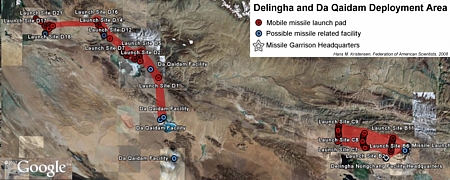 |
| More than 50 launch pads for nuclear ballistic missiles have been identified scattered across a 2,000 square kilometer (772 square miles) area of central China, according to analysis of satellite images. Click image for full size. Also download GoogleEarth KMZ file. |
.
By Hans M. Kristensen
Analysis of new commercial satellite photos has identified an extensive deployment area with nearly 60 launch pads for medium-range nuclear ballistic missiles in Central China near Delingha and Da Qaidam.
The region has long been rumored to house nuclear missiles and I have previously described some of the facilities in a report and a blog. But the new analysis reveals a significantly larger deployment area than previously known, different types of launch pads, command and control facilities, and missile deployment equipment at a large facility in downtown Delingha.
The U.S. government often highlights China’s deployment of new mobile missiles as a concern but keeps the details secret, so the discovery of the deployment area provides the first opportunity for the public to better understand how China operates its mobile ballistic missiles.
Description of Deployment Area
The deployment area is located in the northern parts of the Qinghai province and consists of two areas west of Delingha and Da Qaidam. In total, 58 launch pads have been identified scattered over an area stretching roughly 275 kilometers (170 miles) along highway G315 leading from Delingha through Da Qaidam to Mahai (see banner image for details). Nearly all launch pads detected so far are located on the north side of the road. Combined, the deployment area covers approximately 772 square miles (2,000 square kilometers).
|
Figure 1: |
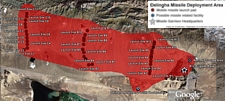 |
|
36 launch pads and the 812 Brigade Base have been identified in and around Delingha. Click on image to see full size |
The Delingha (德令哈) deployment area stretches approximately 52 kilometers (32 miles), covering 1,000 square kilometers (386 square miles) west of the city of Delingha (see Figure 1). A total of 36 launch pads have been identified along three side roads extending north from the main road. The three strings of launch pads are separated by 16-20 kilometers (10-12 miles). This area appears to be very active with missile operations detected in 2005 and 2007, and several facilities in downtown Delingha associated with missile operations are identified below.
|
Figure 2: |
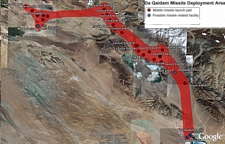 |
|
22 launch pads have been identified northwest of Da Qaidam. Click on image for full size |
The Da Qaidam deployment area stretches for more than 100 kilometers (62 miles) west of the city of Da Qaidam Zhen all the way past Mahai, covering an area of 1,100 square kilometers (424 square miles). A total of 22 launch pads have been identified alongside and to the north of the main road (see Figure 2). This deployment area shows clear wheel tracks at several of the pads, including what might be construction of new pads or maintenance of existing ones. Unlike in Delingha, no missile related facilities have yet been identified in or around Da Qaidam itself, except for what appears to be a surface-to-air missile (SAM) site in the city itself and what might be a command and control facility further south near Xiao Qaidam.
There are probably more launch pads and facilities between Delingha and Mahai, but satellite photos of a couple of areas are not yet available on Google Earth.
From these launch pads DF-21 missiles would be within range of southern Russia and northern India (including New Delhi), but not Japan, Taiwan or Guam.
|
Figure 3: |
 |
|
Four basic launch pad designs have been detected ranging is size from 15-70 meters. |
Launch Pad Designs
The 58 launch pads include four basic designs: a 70-meter full circle; a 40-meter T-shape, a 15-45 meter rectangular, and a 30-meter pull-out (see Figure 3). The 15-meter rectangular is by far the most common design. There are two full circle pads and four T-shape pads.
The large circular pads are probably older designs for the liquid-fuel DF-3 and DF-4, which require a large number of fuel trucks on the pad until shortly before launch. The liquid-fuel missiles are now being phased out and replaced with the solid-fuel DF-21 and DF-31, which require fewer support vehicles. The DF-31 has not been reported in the Delingha and Da Qaidam areas, but its smaller predecessor the DF-21 has deployed there for several years and can be launched from the small 15-meter pads. Two of the pads in Figure 3 show what are estimated to be DF-21 launchers, a 2006 deployment previously described here.
The pads could potentially also be used by short-range missiles such as the DF-11 and DF-15. But the DOD has repeatedly stated in its annual reports on China’s military that “all of [China’s] SRBM units are deployed to locations near Taiwan.”
Several of the smaller 15-meter launch pads appear to have a small infrastructure consisting of a tiny building located approximately 150 meters from the pad. A few also have larger structures nearby.
Command and Control Facilities
The satellite photos also show what appear to be buried command and control (C2) facilities at each deployment area. They are hard to find because they blend in with the other pads, but a closer look reveals that they are very different and so far two have been detected (see Figure 4).
The two C2 facilities have the same dimensions, 20 x 16 meters, and each has a tall antenna at either end of what looks like a concrete pad. The pads might cover buried facilities used for C2, or be used by C2 vehicles that deploy with the missile launcher.
The facilities face the same direction, and lines drawn from each antenna parallel to the end of the facilities run through Delingha as well as Wulan (Ulan) further to the southeast, a rumored location of the headquarters for the missiles in this area.
|
Figure 4: |
 |
| Two of the pads (sites A4 and D1) have twin antennae and appear to be command and control facilities. |
.
Likewise, a string of facilities with antennae south of Da Qaidam near Xiao Qaidam might also be related to command and control operations.
Missile Activities Downtown Delingha
Traveling through Delingha a few years ago, a group of hikers described the encounter: “While trying to find accommodation we got stopped by police, one of them did some cell phoning and then offered to find a hotel for us, we were impressed! Once in the hotel there was a knock on the door- and we were confronted with ‘Alien Police’ who informed us we were in a closed city where no foreigners were allowed.”
Whether the hikers were deported because Delingha houses a nuclear missile brigade is unknown, but in the past it has been difficult to identify facilities in the city related to missile operations. A satellite photo taken on February 28, 2008, however, shows structures similar to those observed on remote launch pads outside the city in 2005 and 2006. The structures can be seen at three locations inside a 1.5 x 0.5 kilometer (0.7 x 0.3 mile) compound (see Figure 5), and appear to reveal the location of the 812 Brigade Base Headquarters for the first time.
|
Figure 5: |
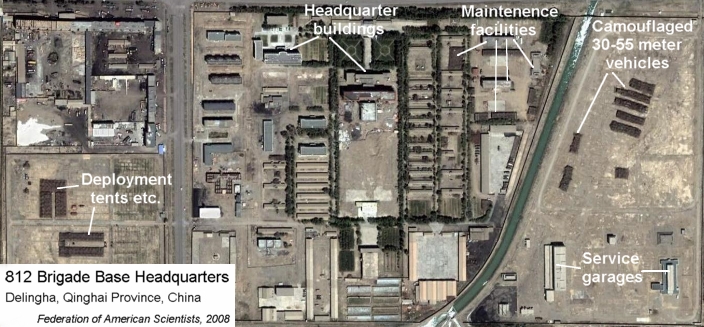 |
| Missile related facilities and equipment reveal the location of the 812 Brigade Base in downtown Delingha. Click on the image for full size. |
.
A square fenced section in the western part of the base compound is dominated by two large c-shaped structures. Closer inspection reveals that they consist of five tent-like structures, two of which are about 70 meters long and three that are 40 meters. At the end of the two larger tents is what appears to be a gate or portal. Next to the tents are two small buildings and a truck (see Figure 6).
|
Figure 6: |
 |
| Tent-like structures visible in downtown Delingha appear to be used by the missile launch brigade when it deploys to remote launch pads (see also Figure 7). |
.
These structures are hard to identify by themselves, but when comparing with earlier satellite photos from the same area they become significant because they are very similar – if not identical – to structures seen on dispersed launch pads near Delingha in 2005 and 2006. Two of those cases are reproduced in Figure 7, showing an 80-meter tent, 43 crew tents/huts, a gate, and six fuel trucks at Launch Pad B1 in 2005, as well as a DF-21 launcher with a crew tent/hut at Launch Pad B10 in 2006.
|
Figure 7: |
 |
| Tent-like structures similar to the ones detected in downtown Delingha (see Figure 6) were deployed to missile launch pads in 2005 (right) and 2006. |
.
At the eastern end of the compound is another large open facility with what appears to be camouflage nets covering unidentified vehicles. The relatively low resolution of the photos conceal many details, and it’s difficult to say whether they are vehicles or stacked equipment, how long they have been there, and whether they’ve just arrived or are being shipped out. Yet their sizes (27-56 meters) and shapes are particularly interesting because the length of the DF-21 launcher is approximately 13 meters and the DF-31 launcher is about 23 meters. At the south end of this facility are two large buildings that might be service garages for missile launchers (see Figure 8).
|
Figure 8: |
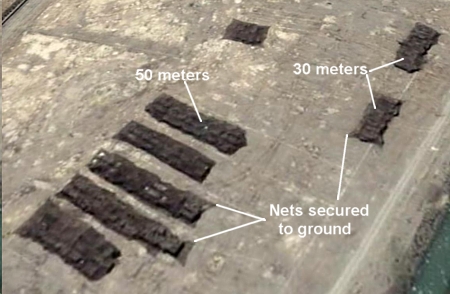 |
| Equipment similar in size to launch platforms is covered by camouflage nets. Two buildings at the south end of the facility resemble service buildings for launchers. |
.
Immediately to the west of this facility, separated by a canal, a triangle-shaped section of the main compound appears to be associated with servicing the missile units and their equipment. Clearly visible are several tents of the same basic design as those seen in the western facility and on launch pads, as well as three smaller huts and the shadow of what seems to be a gate/portal (see Future 9).
|
Figure 9: |
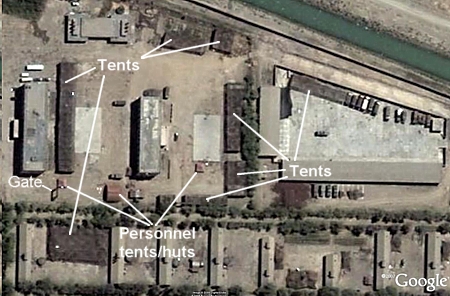 |
| Tent-like structures, red huts, and a gate/portal similar to those observed at launch sites B1 and B5 in 2005 and 2006 identify this section of the Delingha base as a possible service facility for mobile ballistic missile launchers. |
.
Implications of a Mobile Missile Force
The current head of China’s Second Artillery Corps, General Jing Zhiyuan, reportedly served as commander of the Second Artillery Base 56 in Xining, the headquarters for the Delingha missile brigade, from 1993 to 1997. As such he would have overseen the preparations for the transitioning from old liquid-fuel missiles at Delingha and Da Qaidam to solid-fuel missiles.
This change, one all the other nuclear powers made decades ago, is in full swing through the Chinese missile force. Several of the small pads detected at Delingha and Da Qaidam have been added since 2005. At that time approximately 33 of China’s deployed 91 ballistic missiles were solid-fuel, corresponding to 36 percent. Today the share is 67 out of 121 deployed missiles, or 55 percent. The share will increase in the next several years as more DF-31s and DF-31As are deployed and the DF-3As and DF-4s are retired. JL-2 missiles on Jin-class submarines will increase the percentage even more.
Similarly to the other nuclear weapon states, China is trying to reduce the vulnerability of its nuclear deterrent, and much of the debate about the new mobile missiles centers on their ability to disperse and launch quickly, making them harder for others to destroy. The small 15-meter launch pads are indeed easy to overlook compared with the larger 70-meter pads, and it is not known which of he pads will be used by launchers in a war; they might even be capable of launching from the main road. The tire tracks visible in the images and the absence of paved roads to most of the launch pads suggest the DF-31 launchers have some off-road capability.
Even so, the relatively low-resolution satellite images show that even mobile missile leave fingerprints such as tire tracks and rely on a highly visible infrastructure that includes the launch pads themselves, command and control facilities, and bases. Moreover, targeting Chinese mobile systems is far from a new and untested challenge for U.S. military planners because China and Russia have deployed – and the United States has routinely targeted – their mobile ballistic missiles since the early 1980s. Indeed, the DOD’s determination that all of China’s smallest mobile missile units – those that are hardest to detect and the most numerous – are confined to one region and nowhere else in this vast country suggests that a considerable detection (and thus targeting) capability exists today.
Mobile missiles might make it more difficult to carry out a successful first strike to destroy all of the launchers, but it doesn’t make the force invulnerable. If hidden inside a cave it is relatively simple to seal off the entrance and trap the launchers inside. Once out in the open mobile launchers can move and try to hide, but they are highly vulnerable to the blast effect of a nuclear weapon. The specific targeting and damaging requirements for U.S. nuclear forces tasked with targeting Chinese mobile missiles are not know. But the following excerpt from The U.S. Nuclear War Plan: A Time For Change (NRDC 2001, p. 54) about targeting Russian mobile SS-25 ICBMs might be a good illustrative example for targeting Chinese mobile missiles as well:
| “The 1969 Defense Intelligence Agency Physical Vulnerability Handbook—Nuclear Weapons assigns a vulnerability number of 11Q9 to road-mobile missiles with ranges of 700, 1,100, and 2,000 nautical miles or with intercontinental ranges. The damage level for this vulnerability number is defined as “transporter overturned and missile crushed.” The kill mechanism has been likened to flipping a turtle on its back. For a 100-kt weapon [the W76], the optimum height of burst to attack a target with a vulnerability number of 11Q9 is approximately 1,250 m (no local fallout would be expected), and the corresponding damage radius is 2,875 m. Thus dispersed SS-25 vehicles can be threatened over an area of approximately 26 square kilometers by a single W76 air burst. If, for example, a MAZ vehicle is traveling at 20 kilometers per hour, then one W76 explosion must occur within about 15 minutes of noting the location of the moving vehicle. While this time interval is roughly consistent with depressed-trajectory launches of SLBMs, it would require additional time to communicate the SS-25 locations to the SSBNs and retarget the missiles. The fact that Trident I or Trident II SLBMs are MIRVed, with up to eight [now estimated to be six] warheads per missile, means that a group of moving SS-25 launcher vehicles could also be pattern-attacked with W76 warheads over an area of some 200 square kilometers.” |
.
Using this example as a guide, it would require at least 24 100-kiloton W76 warheads – the load of four Trident II D5 missiles – detonating at a height of burst of 1,250 meters to ensure destruction of all the 58 launch pads identified in these satellite images, plus several more warheads to destroy the bases. Rather than aiming at each pad, warfighters would more likely try to hit the launchers before they dispersed.
The mobile nuclear cat and mouse game is on: Chinese planners are trying to hide and U.S. and Russian planners are trying to catch them.
Additional information: Chinese Nuclear Forces and U.S. Nuclear War Planning | GoogleEarth KMZ File
Nukes in the Taiwan Crisis
.
By Hans M. Kristensen
Thanks to the efforts of Bill Burr at the National Security Archive, some of the veil covering U.S. nuclear war planning against China in the 1958 Taiwan Strait crisis now has been lifted by a declassified military study.
It shows that on the day after the Chinese began shelling the Quemoy islands on August 23, 1958, U.S. Air Force Headquarters apparently assured Pacific Air Forces “that, assuming presidential approval, any Communist assault upon the offshore islands would trigger immediate nuclear retaliation.” Yet President Dwight D. Eisenhower fortunately rejected the use of nuclear weapons immediately, even if China invaded the islands, and emphasized that under no circumstances would these weapons be used without his approval.
Caution against nuclear use didn’t mean not planning for it, however, and in the years after the Taiwan Strait crisis an enormous nuclear build-up occurred in the Far East. The numbers started to decline in the 1970s, and for a period during the 1980s and first half of the 1990s, nuclear planning against China was reduced to reserve force contingencies. In the past decade, however, China has again become a focus for U.S. nuclear strike planning.
The Available Nuclear Bombs
Shortly after the Chinese shelling of Quemoy began, General Nathan Twining, the Chairman of the Joint Chiefs of Staff, explained during a meeting with President Eisenhower’s cabinet that U.S. aircraft at the outset would drop 10-15 kilotons nuclear bombs on selected fields in the vicinity of Amoy (Xiamen). The Pacific Air Forces drew up a contingency plan based on the assumption that the United States would carry out the nuclear strikes necessary to defeat the attacking Chinese forces.
At that time, the Matador nuclear cruise missile was already deployed in Taiwan. The missile could deliver a 20 kt W5 warhead to a range of about 965 km (600 miles). From Taiwan, the Matador could potentially have hit Chinese troop concentrations around Amoy, but General Twining apparently favored bombs. Nuclear bombs, however, did not arrive in Taiwan until January 1960, but a declassified document previously released to me under FOIA shows they were available on Guam and Okinawa. The bombs included three types – Mk-6 (only Guam), Mk-36 Mod 1, and Mk-39 Mod 0 – with yields ranging from 8 kilotons to 10 megatons (see Table 1).
| Table 1: Nuclear Bombs Deployed Near Taiwan, June 1958 |
|||
| Base | Bomb Type | Yield(s) | Custodian Unit |
| Anderson AFB, Guam |
Mk-6 Mk-36 Mod 1 Mk-39 Mod 0 |
8, 22, 61, 160 kt 10,000 kt ~3,750 kt |
3 ADS |
| Kadena AB, Okinawa | Mk-6 Mk-39 Mod 0 |
8, 22, 61, 160 kt ~3,750 kt |
12 ADS |
| Sources: U.S. Strategic Air Command, History of the Strategic Air Command 1 January 1958 – 30 June 1958, Historical Study Number 73, Volume 1, n.d. [1959] p. 89. Document obtained under FOIA; Chuck Hansen, Swords of Armageddon, Version 2, 2002. (Table corrected October 21, 2008) |
|||
.
The Mk-6 was a tactical bomb that could be delivered in a ground or airburst mode by a variety of Air Force and Navy aircraft and probably would have been the weapon of choice for the Taiwan scenario. The Mk-36 and Mk-39 were both strategic megaton weapons more suited for use against large area targets such as cities or to “dig up” underground facilities.
In mid-August, five Strategic Air Command B-47 bombers on Guam were put on alert to conduct nuclear strikes against airfields on the Chinese mainland if necessary. Such attacks would be necessary, General Twining said, if initial nuclear strikes against troop concentrations failed to cause China to lift their blockade of Quemoy.
|
Figure 1: |
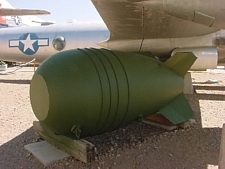  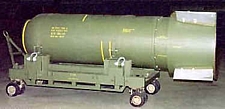 |
|
At the time of the 1958 Taiwan Strait crisis, US Strategic Air Command deployed Mk-6, Mk-36 and Mk-39 (top down) nuclear bombs on Guam and Okinawa (only Mk-36 and 39). |
The Nuclear Posture After The Taiwan Crisis
Fortunately the general didn’t have his way and the declassified study obtained by Burr concludes that the “principal question” raised by the crisis was: “Would the American military in future crises encounter cautious presidential control over nuclear weapons?” Fortunately it did, but although this reality caused the military to focus more on non-nuclear warfare, it did little to stem the forward deployment of large numbers of nuclear weapons to Northeast Asia at the time.
In South Korea, a few months before the Taiwan Strait crisis erupted, deployment of six U.S. nuclear weapon systems was already underway: the Honest John surface-to-surface missile; the Matador cruise missile; the Atomic-Demolition Munition (ADM) nuclear landmine; the 280-mm gun; the 8-inch (203mm) howitzer; and nuclear bombs for fighter bombers. After the Taiwan Strait crisis cooled down, five more nuclear weapon systems arrived in South Korea: the surface-to-surface missile systems Lacrosse, Davy Crockett, and Sergeant; the dual-mission Nike Hercules anti-air and surface-to-surface missile; and finally the 155-mm Howitzer. At the peak of the build-up in 1967, nearly 950 warheads were deployed in South Korea.
Nuclear weapons also were deployed to Taiwan. As mentioned above, the Matador cruise missile was already present on the island when the Taiwan Strait crisis erupted. The nuclear bombs arrived in January 1960 and stayed for a decade and a half until July 1974. Together with nuclear bombs for tactical fighter wings deployed at Clark Air Base in the Philippines, Kusan Air Base in South Korea and Kadena Air Base on Okinawa, the nuclear bombs in Taiwan probably were intended for use against targets in China and North Korea.
The deployment to Taiwan was not without its problems: After a series of inspections of nuclear weapons facilities in the Far East, the U.S. Senate Foreign Relations Committee in 1970 sharply criticized the U.S. policy that guided the forward deployment as well as the agreements and understandings with the host country about the deployment, use, or withdrawal of these weapons. “One example: …the ranking United States Army officer in [Taiwan] testified he was not aware whether or not nuclear weapons were located on Taiwan.”
After the weapons were withdrawn from Taiwan in July 1974, the three other fighter wings in the Philippines, Okinawa and South Korea continued to be tasked under the SIOP (Single Integrated Operational Plan), the latter as a Quick Reaction Alert strike force. At that time the SIOP included four major attack options, two of which were against China, and three of 11 new Selected Attack Options directed by NUWEP-74 aimed at virtually all elements of Chinese military and industrial facilities.
In 1982, however, China was removed from SIOP planning to reflect the country’s new status as a U.S. partner against the Soviet Union. During this time, nuclear planning against China was confined to a small number of contingency options involving the strategic reserve force and non-strategic nuclear weapons. The Joint Strategic Capabilities Plan (JSCP) for Fiscal Year 1984, for example, did order the preparation of a Contingency Plan (CONPLAN) for the employment of nuclear weapons against China’s power projection capabilities (presumably ballistic missile and air bases). But this requirement was short lived and was dropped again in the FY85 JSCP.
Taiwan and China in Recent Nuclear Planning
Sixty years after the shelling of Quemoy islands, China and the Taiwan Strait remain a center for U.S. military planning and a potential trigger for a nuclear conflict between the United States and China. But with the glossy Soviet Military Power from the 1980s replaced by Military Power of the People’s Republic of China as the Pentagon’s most prominent unclassified annual threat report – and most U.S. ballistic missile submarines now patrolling in the Pacific instead of in the Atlantic as during the Cold War, and bomber squadrons periodically forward-deploying to Guam – China appears to have taken center stage.
The rise of China in recent U.S. nuclear planning occurred gradually in the 1990s after the Soviet Union fell apart and the Cold War faded. Coinciding with U.S. intelligence reports about China’s slow but steady modernization of long-range strategic nuclear forces, some military planners began arguing that it was necessary to begin to target China on a more ongoing and fundamental basis.
During the 1994 Nuclear Posture Review, STRATCOM and some DOD officials unsuccessfully lobbied for increasing nuclear planning against China. One example of this effort was STRATCOM’s Sun City Extended nuclear force structure study from 1994, which – unlike the Sun City study completed a year earlier – dedicated more than a dozen pages to analyzing China scenarios. It identified two: a US/North Korea/China excursion involving less than a full-scale attack against China; and a US/China confrontation involving a major-attack response plan (see Figure 2).
|
Figure 2: |
 |
| A 1994 STRATCOM nuclear force structure study identified two China scenarios: one involving North Korea; and a direct US-China confrontation most likely over Taiwan. Document obtained under FOIA. |
.
Although advocates for a stronger focus on China failed to change policy in 1994, a new Taiwan Strait crisis in March 1996 provided new impetus after China test launched several short-range ballistic missiles from the mainland into the waters north and south of Taiwan (the northern impact area being only 19 miles from Chilung). The exercise was the latest and largest in a series of what U.S. Naval Intelligence considered to be rehearsals of a contingency scenario for the invasion of Taiwan, a new scenario first detected in 1994. The United States responded by sending two aircraft carrier battle groups to the area.
The following year, in October 1997, President Clinton signed Presidential Decision Directive (PDD)-60, which lowered the targeting requirement against Russia but reportedly at the same time broadened the spectrum of Chinese facilities that could be attacked with nuclear weapons to include the country’s growing military-industrial complex and improved conventional forces. Despite the implications, one official told Washington Post, there was “no debate with respect to the targeting of China.”
The language of PDD-60 was specific enough to allow STRATCOM to formally bring China back into SIOP planning after a hiatus of 16 years. A classified STRATCOM study from 1999 labeled China as “a growing force,” and one of STRATCOM’s first acts was to build the CHISOP, the Chinese Integrated Strategic Operations Plan, to “war game” that force against U.S. nuclear forces. CHISOP was similar to the RISOP (Red Integrated Strategic Operations Plan), a hypothetical Russian war plan that had existed for many years. But whereas China in RISOP was “war gamed” as part of the “blue force” against the Soviet Union and Russia, one effect of PDD-60 was that China in the planning became an independent “red force.” The CHISOP was intended to serve as a “single-point estimate” of Chinese strategic capabilities and potential employment by using available intelligence information about Chinese nuclear weapon systems, strategy, and policy in “war games” to assess the effectiveness of U.S. nuclear strike plans against China.
|
Figure 3: |
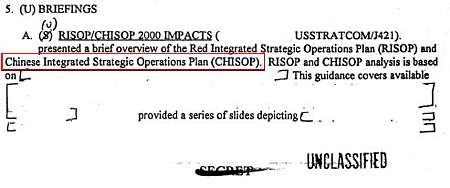 |
| Following President Clinton’s signing of PDD-60 in October 1997, which reportedly authorized a broadening of nuclear targeting against China, STRATCOM began designing CHISOP, the Chinese Integrated Strategic Operations Plan, a parallel to the RISOP (Russian Integrated Strategic Operations Plan) previously used to “war game” U.S. and Russian nuclear forces. Document obtained under FOIA. |
.
It was around this time that the Bush administration’s Nuclear Posture Review in late 2001 identified a military confrontation over the status of Taiwan as an “immediate contingency” influencing the sizing U.S. nuclear forces. China, due to its still evolving strategic objectives and ongoing modernization of nuclear and non nuclear forces, was described as a country that “could be involved in an immediate or potential contingency.”
Yet CHISOP appears to have been short lived, at least with that name. In early 2005, RISOP was canceled and with it, presumably, the efforts to build the CHISOP. The cancellation probably reflected a change in U.S. strategic war planning of which only little is known, coinciding with the publication of a new Nuclear Weapons Employment Policy (NUWEP) document in 2004 and a major revamping of the U.S. strategic nuclear war plan in October 2004 (OPLAN 8044 Revision 05). CHISOP and RISOP were probably incompatible with modern planning because they were products of the Soviet-focused planning for the SIOP, which has since been converted into a “family of plans applicable in a wider range of scenarios” with “more flexible options” against potential “adversaries in a wider range of contingencies.”
CHISOP or not, however, the March 2006 Quadrennial Defense Review underscored the central status of China in U.S. planning: “Of the major and emerging powers, China has the greatest potential to compete militarily with the United States” as it “continues to invest heavily in its military, particularly in its strategic arsenal and capabilities designed to improve its ability to project power beyond its borders.”
Additional information: Chinese Nuclear Forces and U.S. Strategic Nuclear War Planning | White House Guidance Led to New Nuclear Strike Plans Against Proliferators, Document Shows
New Chinese SSBN Deploys to Hainan Island
By Hans M. Kristensen
The Chinese navy has deployed a Jin-class (Type 094) ballistic missile submarine to a new base near Yulin on Hainan Island on the South China Sea, according to a satellite image obtained by FAS. The image shows the submarine moored at a pier close to a large sea-entrance to an underground facility.
Also visible is a unique newly constructed pier that appears to be a demagnetization facility for submarines.
A dozen tunnels to underground facilities are visible throughout the base compound.
The satellite image, which has also been described in Jane’s Defense Weekly, was taken by the QuickBird satellite on February 27, 2008, and purchased by FAS from DigitalGlobe.
The Arrival of the Jin-Class Submarine
The dimensions of the submarine in the satellite image are similar to the Jin-class SSBN I spotted at Xiaopingdao Submarine Base in July 2007 and the two Jin-class SSBNs I detected at the Bohai shipyard in October 2007.
China is believed to have launched two Jin-class SSBNs with a third possibly under construction. The U.S. Intelligence community estimates that China might possibly build five SSBNs if it wants to have a near-continuous deterrent at sea. Of course, it is not known whether China plans to operate its SSBNs that way. See Figure 1 for the location of the submarine.
.
Missile loadout of the SSBN will probably take place at pierside at the main pier to the left of the narrow triple-pier where the submarine is seen, unless the underground facility is large enough to permit such operations out of satellite view. Not yet visible at the base is a dry dock large enough to accommodate an SSBN; the Northern Fleet submarine base at Jianggezhuang has a dry dock.
New Demagnetization Facility
One of the most interesting new additions to the base is what appears to be a submarine demagnetization facility (see Figure 2). Located in the southern part of the base and connected by pier to a facility on a small island, the demagnetization facility closely resembles such facilities at U.S. SSBN bases. Demagnetization is conducted before deployment to remove residual magnetic fields in the metal of the submarine to make it harder to detect by other submarines and surface ships. There is no demagnetization facility at the Jianggezhuang base, so this appears to be a new capability for China.
|
Figure 2: |
 |
| Since 2005, what appears to be a submarine demagnetization facility has been added to the base. Click on image for larger photo. |
.
Underground Facilities
The base has extensive underground facilities. The most obvious is a large portal over a sea-entrance to what is probably an underground facility. The entrance appears to be approximately 3 meters (15 feet) wider than a similar entrance at the Northern Fleet Jianggezhuang Naval Base (see Figure 3 for comparison).
|
Figure 3: |
 |
| The submarine cave entrance at Yulin Naval Base (top) is approximately 3 meters wider than the one at Jianggezhuang Naval Base. Click on image for larger photo of the Yulin entrance. Description of the Jianggezhuang facility is available here. |
.
Although the interior of the facility is not known, it probably includes a canal at least the length of one submarine as well as halls for handling or possibly storing equipment as well as rooms for personnel. Directly on the other side of the mountain are several land-entrances that might connect to the central facility as well, although none of this is known for sure. Two of those entrances appear from their shadows to be very tall structures (see Figure 4).
.
Some Implications
The SSBN base on Hainan Island will probably be seen as a reaffirmation of China’s ambitions to develop a sea-based deterrent. To what extent the Chinese navy will be capable of operating the SSBNs in a way that matters strategically is another question. China’s first SSBN, the Xia, was no success and never sailed on a deterrent mission. As a consequence, the Chinese navy has virtually no tactical experience in operating SSBNs at sea. Yet the Jin-class and the demagnetization facility on Hainan Island show they’re trying.
The location of the base is important because the Indian government already has pointed to a future threat from Chinese missile submarines operating in the South China Sea or Indian Ocean. The arrival of the Jin-class in Hainan will probably help sustain India’s own SSBN program. For China to sail an SSBN into the India Ocean and operate it there in a meaningful way, however, will be very difficult and dangerous in a crisis. Chinese SSBNs are more likely to stay close to home.
The base on Hainan Island is near deep water and some analysts suggest this will support submarine patrols better that operations from the Northern Fleet base at Jianggezhuang. Of course, if the water is so shallow the submarine can’t submerge fully it will limit operations, but deep water is – contrary to popular perception – not necessarily an advantage. Military submarines generally are not designed to dive deeper than 400-600 meters, so great ocean depth may be of little value. The U.S. navy has several decades of experience in trailing Soviet SSBNs in the open oceans; shallow waters are much more challenging. And the South China Sea is a busy area for U.S. attack submarines, which have unconstrained access to the waters off Hainan Island. And I’d be surprised if there were not a U.S. “shadow” following the Jin-class SSBN when it arrived at Hainan Island.
Additional information: Chinese Nuclear Forces and U.S. Nuclear War Planning | Chinese Submarine Patrols Rebound in 2007, but Remain Limited | A Closer Look at China’s New SSBNs

